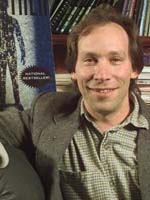 |
Einstein's Greatest Blunder Dr. Lawrence Krauss Case Western University Friday May 10th |
|
Who is Dr. Lawrence Krauss?
|
"The standard model of cosmology of the 1980’s is now dead. Its replacement may be far more bizarre."
|
| Dr. Lawrence Krauss, Professor of Physics at Case Western University is a leading popularizer of physics, author of The Physics of Star Trek, but equally recognized as a leading researcher – recommended to us by Dr. Stephen Hawking. His recent book Quintessence addresses the hottest issue in modern cosmology – the acceleration of the expansion of the universe, forcing us to rethink the dark matter/energy problem as well as many others. | Cosmology has a lot going for it at the moment. Unprecedented amounts of data characterizing the universe at almost every possible energy and length-scale make it one of the richest scientific fields around. Theorists scramble to explain all of the disparate results, while experimentalists and observers push the limits of what, only a few years ago, was not thought possible. Most of the energy in the Universe may reside in otherwise completely empty space! This is the strangest possibility that one can imagine. Krauss will describe the possible implications for our understanding of nature, and for life, of this astounding new result. Dr. Lawrence Krauss, Professor of Physics at Case Western Reserve University, is a pioneer at the interface between elementary particle physics and cosmology, where his studies include the early universe, the nature of dark matter, general relativity and neutrino astrophysics. Since 1996, Dr. Krauss has given more than 300 lectures and media interviews around the world. In 2000 he was awarded the AAAS’s Award for the Public Understanding of Science and Technology. According to Stephen W. Hawking, author of A Brief History of Time, “Lawrence Krauss has Carl Sagan’s knack of expanding the imagination and explaining the myteries of the universe in simple terms.” Dr. Krauss is the author of over 180 scientific publications, as well as numerous popular articles on physics and astronomy. Krauss is the author of six books, including internationalbest-seller, The Physics of Star Trek, where he used the popular science-based TV series to introduce and to explain the fundamental concepts of modem physics. Krauss’s most recent book, Atom: An Odyssey from the Big Bang to Life on Earth ... and Beyond, is a companion book to a five-part PBS series. About his research Krauss says: “I have become increasingly interested in utilizing the Universe as a laboratory to study fundamental physics. While the past twenty years or so has seen incredible progress in our understanding of fundamental interactions, key puzzles remain. What is the mechanism for electroweak symmetry breaking? How was the Baryon number of the universe generated? What phase transitions occurred in the Early Universe, and what are the observable consequences in the present universe? How can we probe for new gravitational physics? How did large scale structure form? and, Is quantum gravity consistent with quantum mechanics?” “Finally, I believe science is in part a vital cultural activity, which should be shared far more broadly than it is, especially in our modern technological society.” |